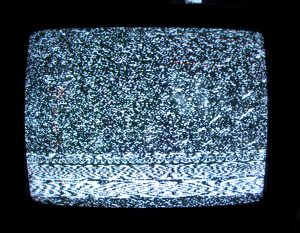I’m going to try at a few shorter blog posts this weekend and publish them as I finish them. The first one is an informal, rather collage-like response to Hayles’ chapter.
…”an infusion of noise into a system can cause it to reorganize at a higher level of complexity”…(Hayles, “Virtual Bodies and Flickering Signifiers“)
This ^^ seems like one of the most optimistic takes on present reality ever, but more about that later.
What does Hayles mean when she says “noise”? Does noise mean chaos? Obviously she’s not talking about noise as a simply aural exchange of waves  hitting an eardrum or other interpretative organ of sound. What is noise when we’re speaking of information?
hitting an eardrum or other interpretative organ of sound. What is noise when we’re speaking of information?
Shift occurs in this chapter after the above statement to a discussion of the material conditions of writing and how they changed between hand-to-pen script, the manual typewriter, and electronic media (presumably electric typewriters into word processing). In the flickering signals of electric text, text is both absent and present. This is a constant of intermediacy, the flickering that looks present, but is actually in and out and a bit unstable. We can better grasp the instability of electronic text thinking about downtimes, lost files, recovery processes. We can lose a book but we are certain that the lost book still exists in the material world. A lost file is a pattern lost to an indeterminable virtual space that must be reconstituted from data–a pattern that must be reclaimed from the noise of other data.
“Reality is not my best window.”–participant in Sherry Turkle’s MUD.
The material nature of books and other print texts, as Hayles points out, is only becoming noteworthy now to us. Last semester, faculty in the Writing Program where I teach were as delighted as children to attend a workshop  given by our university library on making tiny books from scratch. Print books, or even better, handmade ones, have a preciousness to them now. In a time when most people are losing their ability to write out things in legible longhand, there is a premium market for handcrafted embossed leather journals to be filled by hand. This can be related back to last week’s discussion of hypermedia, I think. The elements of a printed book that were once relegated to the background of awareness can become their most prominent and appealing feature.
given by our university library on making tiny books from scratch. Print books, or even better, handmade ones, have a preciousness to them now. In a time when most people are losing their ability to write out things in legible longhand, there is a premium market for handcrafted embossed leather journals to be filled by hand. This can be related back to last week’s discussion of hypermedia, I think. The elements of a printed book that were once relegated to the background of awareness can become their most prominent and appealing feature.
Even this WordPress site: in the dashboard where I am typing this post, there is an appearance of presence of words, but as my fingers fly over the keyboard, stopping and starting, backing up and erasing, I cannot use any language that actually states what I am doing. I am not flying. I am not erasing anything. I’m managing data, organizing it in a series of patterns via keyboard/computer/server. The language I generally use to say this is archaic, metaphoric. But I don’t want to give it up.
“The pattern/randomness does not erase the material world: information in fact derives its efficacy from the material infrastructures it appears to obscure” (Hayles 43).
Looking at this Dashboard (what we call the organization of digital tools we use to pull patterns of meaning out of the noisy data being input and processed and put out again), I see columns that are just the surface of what I imagine is possible for this blog to do and say and organize. Behind every plugin is a story and people. But what about the activity that the plugins do without human intervention? The programs are creating patterns out of noise, too, without any intervention from me, although I can intervene in small ways to sometimes make big changes in the way they do this. And I have the ability to crash it all down, like I did earlier this week when I uninstalled two instances of WordPress on my server.
Hayles’ stated thesis regards the systemic movement from presence/absence to pattern/randomness in contemporary informatics. Informatics, after Donna Haraway, is “the technologies of information as well as the biological, social, linguistic, and cultural changes that initiate, accompany, and complicate their development” (44). I am interested in how everyone processes this thesis, and  I think that Hayles does well to include examples of how this might manifest. I have two examples that help me to follow. One has to do with online teaching and attendance, which will take us away from texts for a moment. The face-to-face model of classroom teaching rests heavily on the presence and absence of the teacher and the students. Digital technology has changed the way that we relate to this and has made us hyperaware of the oddness of the insistence on presence in education. Online education, in all its various forms–online classes, MOOCs, self-teaching through YouTube, webinars, Twitter conferencing–models this shift from presence/absence to pattern/randomness. An online class is marked by patterns of information exchange and activity rather than attendance.
I think that Hayles does well to include examples of how this might manifest. I have two examples that help me to follow. One has to do with online teaching and attendance, which will take us away from texts for a moment. The face-to-face model of classroom teaching rests heavily on the presence and absence of the teacher and the students. Digital technology has changed the way that we relate to this and has made us hyperaware of the oddness of the insistence on presence in education. Online education, in all its various forms–online classes, MOOCs, self-teaching through YouTube, webinars, Twitter conferencing–models this shift from presence/absence to pattern/randomness. An online class is marked by patterns of information exchange and activity rather than attendance.
Another example is the Sherlock episode mentioned in the syllabus–“A Scandal in Belgravia”–but there are examples all over current television and video channels like YouTube that would be equally fit. I like what “Scandal”  does with flickering signifiers, cell phones, gender relations, and sex–Irene Adler’s dominatrix (pixelmatrix?) is a controller of dispensing informational patterns first and foremost, and she is even for a while able to match Sherlock’s ability to read them. SIB, like all of the new Sherlock episodes, is another obvious and highly successful attempt to remediate a series of beloved books–not the first attempt to do so, but the first one in the post-smartphone era. To take the original Irene Adler of “A Scandal in Bohemia” and read them side-by-side using Hayles as a guide would be an interesting project. Surely Steven Moffat was thinking of a computerized matrix when converting Adler to this new role.
does with flickering signifiers, cell phones, gender relations, and sex–Irene Adler’s dominatrix (pixelmatrix?) is a controller of dispensing informational patterns first and foremost, and she is even for a while able to match Sherlock’s ability to read them. SIB, like all of the new Sherlock episodes, is another obvious and highly successful attempt to remediate a series of beloved books–not the first attempt to do so, but the first one in the post-smartphone era. To take the original Irene Adler of “A Scandal in Bohemia” and read them side-by-side using Hayles as a guide would be an interesting project. Surely Steven Moffat was thinking of a computerized matrix when converting Adler to this new role.
In the image above, Adler is naked, which she calls her “battle suit” to do “battle” with Sherlock Holmes. Sherlock in this series reads people, as we literally see typeface of his thought process across the screen, making sense of the seemingly random details of their clothes, skin, hair, gestures, and other signs of their presence. Here when he is confronted with Adler au naturel, he can’t read her anymore. He associates her in this state with incomprehensible chaos, as you can see by the question marks ??????. But as the episode progresses, this chaotic state propels Sherlock to an even higher state of complexity, astuteness, and speed to read signals and decipher clues.
“In contrast to Lacanian psycholinguistics, derived from the generative coupling of linguistics and sexuality, flickering signification is the progeny of the fascinating and troubling coupling of language and machine.” (Hayles 50)
Do you have an example of evidence like this that focuses Hayles’ thesis? Do you see problems with Hayles’ thesis? If you read further in How We Became Posthuman, where do you think this thesis leads us regarding textual studies?
“The elements of a printed book that were once relegated to the background of awareness can become their most prominent and appealing feature.” I think this is one of the most interesting aspects that Paul Hackman touches on in his analysis of Shelley Jackson’s Patchwork Girl, as well–how hypertext has brought the material and often ignored elements of print culture into the spotlight again. It reminds me of the many opinions (and “findings”) I’ve heard about whether taking notes by hand or on a computer is more effective for students. I’ve personally found that my laptop’s “memory” is much more valuable than my own when I want to go back and search through my notes.
I agree with you: I would not want to go back to taking notes by hand, although I love those handmade journals to touch, look at–lovingly like little pets. There might be some value (unproven) in having youngsters learn longhand and write out some things by hand, but this could also be a romantic notion. Definitely there needs to be more research on the hand-brain connection to see if we miss something valuable/skip a step in cognitive development if we do not write things out by hand. Many educators seem very eager to embrace findings leaning in that direction.
“Hero of War” by Rise Against from the album Appeal To Reason tells a very distinct story of, as you can guess from the title, a soldier.推特账号购买